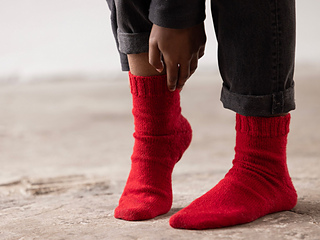patterns >  Filcolana
Filcolana
> Rødstrømper






Rødstrømper
Rødstrømper (Redstockings) was a term for a feminist movement in the 1960s and 1970s. The Red Stocking Movement had a significant impact on Scandinavian society and played an important role in the global feminist movement. The name “Rødstrømper” refers to the red stockings that some of the women wore as a symbol of their activism and solidarity.
The Red Stockings Rebellion contributed to changing laws and attitudes towards greater equality between the sexes.
These Rødstrømper are knitted from the toe up. The heel is a classic hourglass heel, knitted with turning needles. The pattern includes a nice little trick to avoid the small hole that otherwise occurs in the transition between the heel and leg.
Sizes and Measurements
20/21 (22/23) 24/25 (26/27) 28/29 (30/31) 32/33 (34/35)
36 (37) 38 (39) 40 (41) 42 (43) 44 (45) 46
Foot length, from toe to heel (A)
12 (14.5) 15.5 (17) 18 (19.5) 21 (22) cm
23.5 (24) 24.5 (25) 26 (26.5) 27 (27.5) 28 (28.5) 29 cm
Leg height (B)
5 (6) 6 (7) 7 (8) 9 (9) cm
14 (14) 14 (14) 14 (15) 15 (15) 17 (17) 17 cm
Materials
YARN FROM FILCOLANA
Arwetta colour 218 (Chinese Red)
20 (22) 25 (28) 35 (40) 45 (50) g
50 (55) 55 (60) 60 (65) 65 (65) 70 (75) 80 g
Socks with contrast colour on toes, heel and ribbing:
Arwetta col. 990 (Mouliné) and col. 218 (Chinese
Red)
Socks with stripes: Arwetta col. 313 (Bubblegum) and
col. 218 (Chinese Red)
NEEDLES
Circular needles 3 mm, 80-100 cm.
Crochet hook 2.5 or 3 mm.
This pattern is written for Magic Loop method in the
round.
Gauge
34 stitches and 42 rounds in stockinette with 3 mm
needles = 10 x 10 cm.
The needle size is only a guide.
If you have more stitches for 10 cm, change to a bigger
needle size. If you have fewer stitches for 10 cm,
change to a smaller needle size. If you reach the width
but not the required height, it can help to change the
needle type, for example from metal to wood, or vice
versa.
58507 projects
stashed
29485 times
- Page created: August 23, 2024
- Last updated: August 24, 2024 …
- visits in the last 24 hours
- visitors right now




